Abstract
Clinical data were reviewed in 325 patients with prostatic adenocarcinoma followed up for a mean of 13 years. Paraffin-embedded tumour biopsy specimens from the primary tumours were available for flow cytometry (FCM) in 273 cases. Intra-tumour heterogeneity in DNA index (DI) was found in 4% of the tumours (54 cases were analysed). S-phase fraction (SPF) and DNA ploidy were significantly interrelated. Aneuploidy and high SPF were significantly related to both a high T category and high Gleason score. The progression in T1-2M0 tumours was related to Gleason score (P = 0.009), DNA ploidy (P = 0.006) and SPF (P = 0.007), while the Gleason score (P = 0.0013), DNA ploidy (P = 0.002) and SPF (P < 0.001) had prognostic value in univariate survival analysis. In the entire cohort, the T category (P < 0.001), M category (P < 0.001), Gleason score (P < 0.001), DNA ploidy (P < 0.001) and SPF (P < 0.001) were significant prognostic factors. In Cox's analysis, the M category (P < 0.001), Gleason score (P < 0.001), T category (P = 0.003), age (P = 0.001) and SPF (P = 0.087) were independently related to prognosis. In the T1-2M0 tumours, Gleason score (P < 0.001), T category (P = 0.022) and SPF (P = 0.058) were independent predictors. A novel classification system in which the DNA ploidy or SPF and the Gleason score were combined was found to be of significant prognostic value in all M0 tumours (P < 0.001). The results suggest that FCM can be used as an adjunct to conventional histological assessments for determination of the correct prognostic category in prostatic adenocarcinoma.
Full text
PDF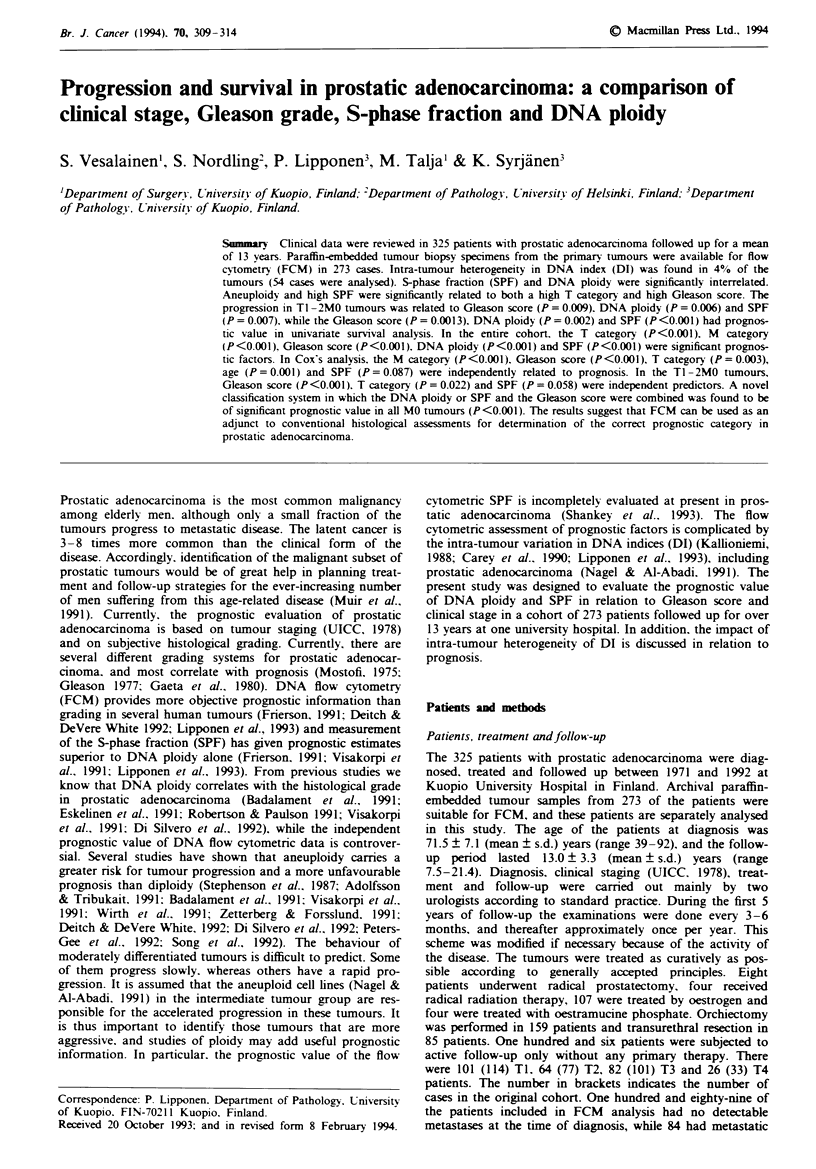
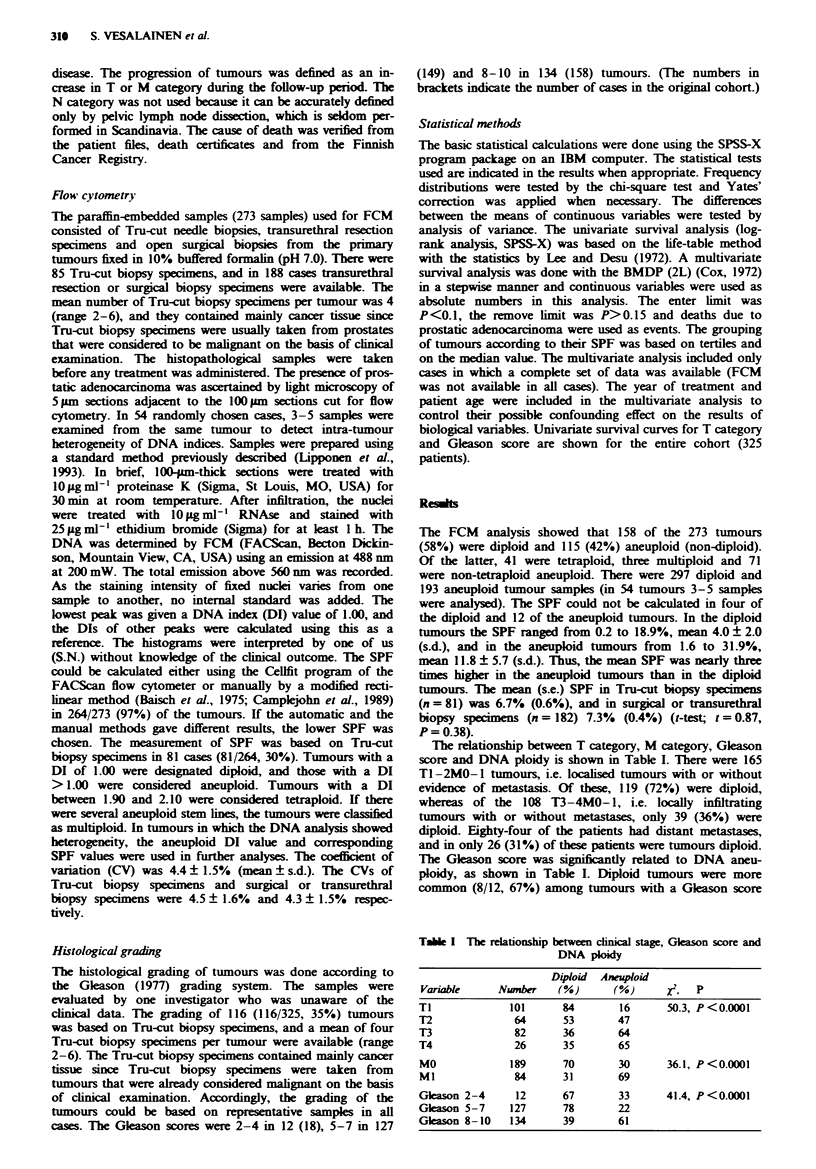
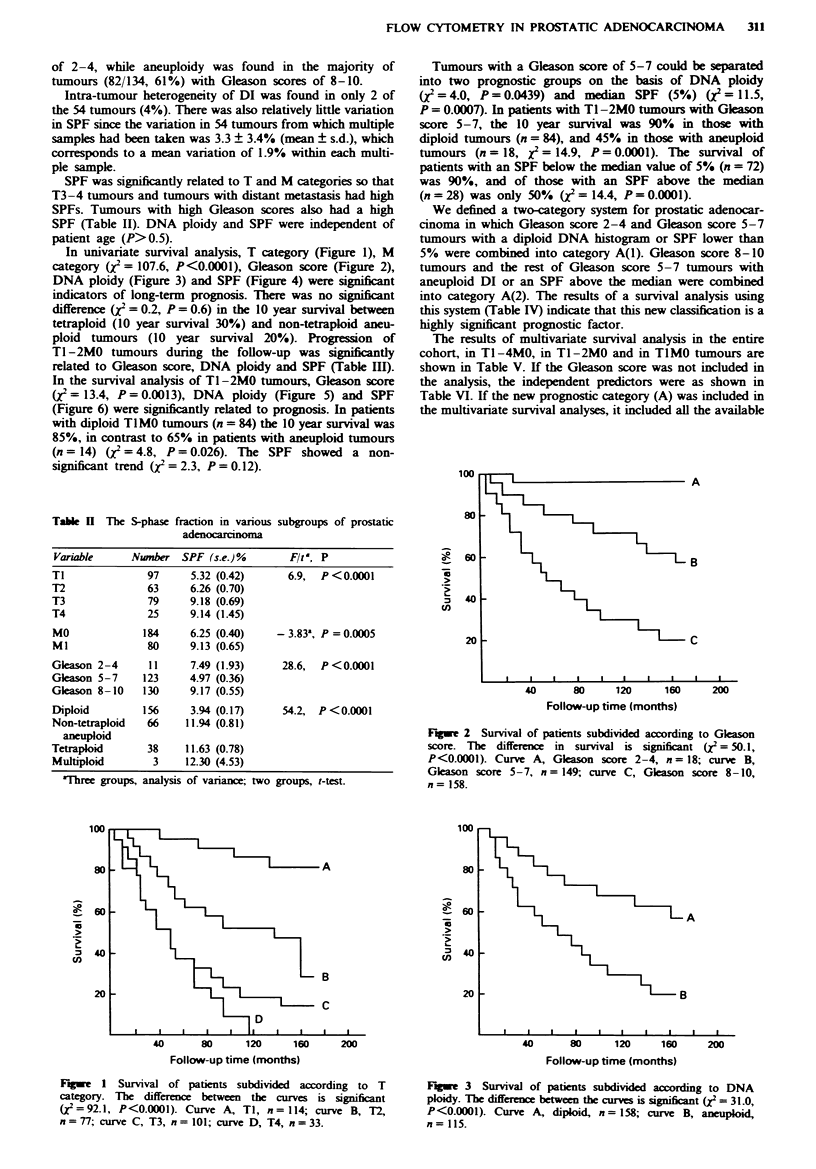
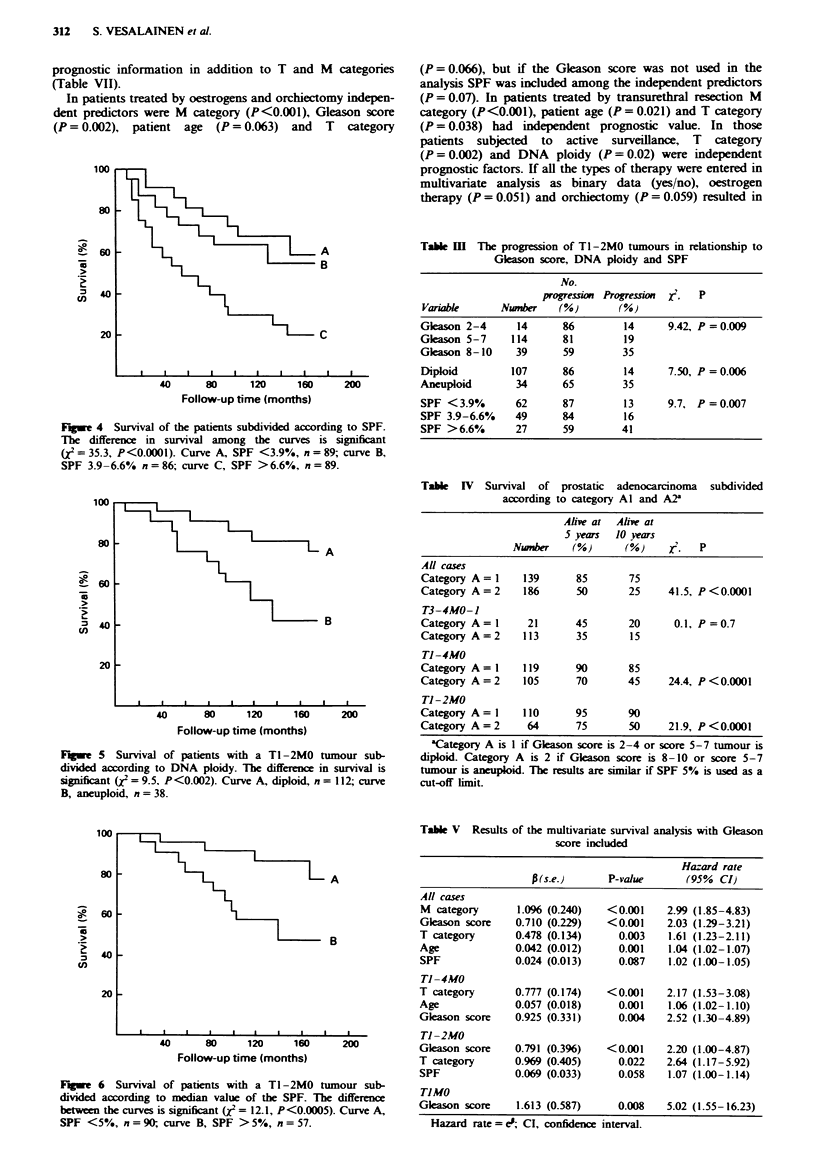
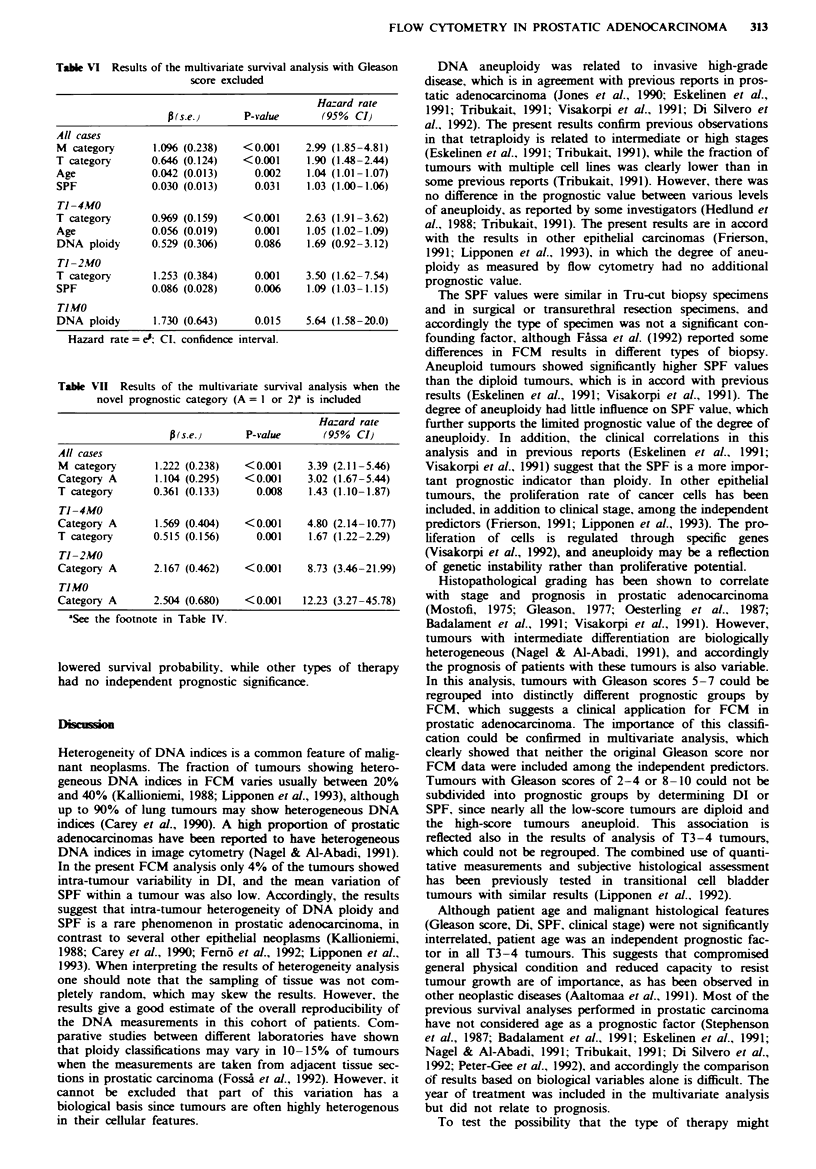
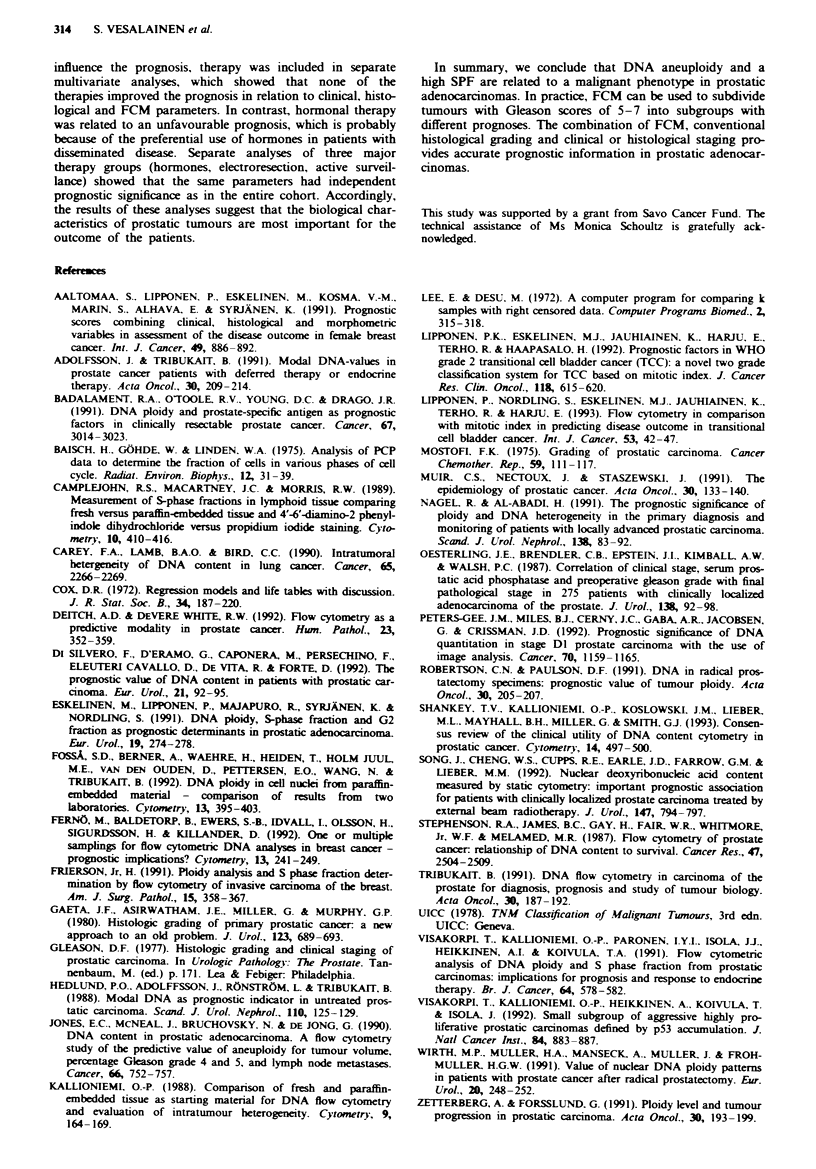
Selected References
These references are in PubMed. This may not be the complete list of references from this article.
- Aaltomaa S., Lipponen P., Eskelinen M., Kosma V. M., Marin S., Alhava E., Syrjänen K. Prognostic scores combining clinical, histological and morphometric variables in assessment of the disease outcome in female breast cancer. Int J Cancer. 1991 Dec 2;49(6):886–892. doi: 10.1002/ijc.2910490615. [DOI] [PubMed] [Google Scholar]
- Adolfsson J., Tribukait B. Modal DNA-values in prostate cancer patients with deferred therapy or endocrine therapy. Acta Oncol. 1991;30(2):209–210. doi: 10.3109/02841869109092352. [DOI] [PubMed] [Google Scholar]
- Badalament R. A., O'Toole R. V., Young D. C., Drago J. R. DNA ploidy and prostate-specific antigen as prognostic factors in clinically resectable prostate cancer. Cancer. 1991 Jun 15;67(12):3014–3023. doi: 10.1002/1097-0142(19910615)67:12<3014::aid-cncr2820671215>3.0.co;2-u. [DOI] [PubMed] [Google Scholar]
- Baisch H., Göhde W., Linden W. A. Analysis of PCP-data to determine the fraction of cells in the various phases of cell cycle. Radiat Environ Biophys. 1975 Jun 13;12(1):31–39. doi: 10.1007/BF02339807. [DOI] [PubMed] [Google Scholar]
- Camplejohn R. S., Macartney J. C., Morris R. W. Measurement of S-phase fractions in lymphoid tissue comparing fresh versus paraffin-embedded tissue and 4',6'-diamidino-2 phenylindole dihydrochloride versus propidium iodide staining. Cytometry. 1989 Jul;10(4):410–416. doi: 10.1002/cyto.990100408. [DOI] [PubMed] [Google Scholar]
- Carey F. A., Lamb D., Bird C. C. Intratumoral heterogeneity of DNA content in lung cancer. Cancer. 1990 May 15;65(10):2266–2269. doi: 10.1002/1097-0142(19900515)65:10<2266::aid-cncr2820651018>3.0.co;2-r. [DOI] [PubMed] [Google Scholar]
- Deitch A. D., deVere White R. W. Flow cytometry as a predictive modality in prostate cancer. Hum Pathol. 1992 Apr;23(4):352–359. doi: 10.1016/0046-8177(92)90081-d. [DOI] [PubMed] [Google Scholar]
- Di Silverio F., D'Eramo G., Caponera M., Persechino F., Eleuteri P., Cavallo D., De Vita R., Forte D. The prognostic value of DNA content in patients with prostatic carcinoma. Eur Urol. 1992;21 (Suppl 1):92–95. doi: 10.1159/000474900. [DOI] [PubMed] [Google Scholar]
- Fernö M., Baldetorp B., Ewers S. B., Idvall I., Olsson H., Sigurdsson H., Killander D. One or multiple samplings for flow cytometric DNA analyses in breast cancer-prognostic implications? Cytometry. 1992;13(3):241–249. doi: 10.1002/cyto.990130305. [DOI] [PubMed] [Google Scholar]
- Fosså S. D., Berner A., Waehre H., Heiden T., Juul M. E., van den Ouden D., Pettersen E. O., Wang N., Tribukait B. DNA ploidy in cell nuclei from paraffin-embedded material--comparison of results from two laboratories. Cytometry. 1992;13(4):395–403. doi: 10.1002/cyto.990130410. [DOI] [PubMed] [Google Scholar]
- Frierson H. F., Jr Ploidy analysis and S-phase fraction determination by flow cytometry of invasive adenocarcinomas of the breast. Am J Surg Pathol. 1991 Apr;15(4):358–367. doi: 10.1097/00000478-199104000-00004. [DOI] [PubMed] [Google Scholar]
- Gaeta J. F., Asirwatham J. E., Miller G., Murphy G. P. Histologic grading of primary prostatic cancer: a new approach to an old problem. J Urol. 1980 May;123(5):689–693. doi: 10.1016/s0022-5347(17)56093-0. [DOI] [PubMed] [Google Scholar]
- Hedlund P. O., Adolfsson J., Rönström L., Tribukait B. Modal DNA as prognostic indicator in untreated prostatic cancer. Scand J Urol Nephrol Suppl. 1988;110:125–129. [PubMed] [Google Scholar]
- Jones E. C., McNeal J., Bruchovsky N., de Jong G. DNA content in prostatic adenocarcinoma. A flow cytometry study of the predictive value of aneuploidy for tumor volume, percentage Gleason grade 4 and 5, and lymph node metastases. Cancer. 1990 Aug 15;66(4):752–757. doi: 10.1002/1097-0142(19900815)66:4<752::aid-cncr2820660426>3.0.co;2-1. [DOI] [PubMed] [Google Scholar]
- Kallioniemi O. P. Comparison of fresh and paraffin-embedded tissue as starting material for DNA flow cytometry and evaluation of intratumor heterogeneity. Cytometry. 1988 Mar;9(2):164–169. doi: 10.1002/cyto.990090211. [DOI] [PubMed] [Google Scholar]
- Lee E. T., Desu M. M. A computer program for comparing K samples with right-censored data. Comput Programs Biomed. 1972 Nov;2(4):315–321. doi: 10.1016/0010-468x(72)90019-0. [DOI] [PubMed] [Google Scholar]
- Lipponen P. K., Eskelinen M. J., Jauhiainen K., Harju E., Terho P., Haapasalo H. Prognostic factors in WHO grade 2 transitional-cell bladder cancer (TCC); a novel two-grade classification system for TCC based on mitotic index. J Cancer Res Clin Oncol. 1992;118(8):615–620. doi: 10.1007/BF01211807. [DOI] [PubMed] [Google Scholar]
- Lipponen P. K., Nordling S., Eskelinen M. J., Jauhiainen K., Terho R., Harju E. Flow cytometry in comparison with mitotic index in predicting disease outcome in transitional-cell bladder cancer. Int J Cancer. 1993 Jan 2;53(1):42–47. doi: 10.1002/ijc.2910530109. [DOI] [PubMed] [Google Scholar]
- Mostofi F. K. Grading of prostatic carcinoma. Cancer Chemother Rep. 1975 Jan-Feb;59(1):111–117. [PubMed] [Google Scholar]
- Muir C. S., Nectoux J., Staszewski J. The epidemiology of prostatic cancer. Geographical distribution and time-trends. Acta Oncol. 1991;30(2):133–140. doi: 10.3109/02841869109092336. [DOI] [PubMed] [Google Scholar]
- Nagel R., al Abadi H. The prognostic significance of ploidy and DNA-heterogeneity in the primary diagnosis and monitoring of patients with locally advanced prostatic carcinoma. Scand J Urol Nephrol Suppl. 1991;138:83–92. [PubMed] [Google Scholar]
- Oesterling J. E., Brendler C. B., Epstein J. I., Kimball A. W., Jr, Walsh P. C. Correlation of clinical stage, serum prostatic acid phosphatase and preoperative Gleason grade with final pathological stage in 275 patients with clinically localized adenocarcinoma of the prostate. J Urol. 1987 Jul;138(1):92–98. doi: 10.1016/s0022-5347(17)43003-5. [DOI] [PubMed] [Google Scholar]
- Peters-Gee J. M., Miles B. J., Cerny J. C., Gaba A. R., Jacobsen G., Crissman J. D. Prognostic significance of DNA quantitation in stage D1 prostate carcinoma with the use of image analysis. Cancer. 1992 Sep 1;70(5):1159–1165. doi: 10.1002/1097-0142(19920901)70:5<1159::aid-cncr2820700522>3.0.co;2-l. [DOI] [PubMed] [Google Scholar]
- Robertson C. N., Paulson D. F. DNA in radical prostatectomy specimens. Prognostic value of tumor ploidy. Acta Oncol. 1991;30(2):205–207. doi: 10.3109/02841869109092351. [DOI] [PubMed] [Google Scholar]
- Shankey T. V., Kallioniemi O. P., Koslowski J. M., Lieber M. L., Mayall B. H., Miller G., Smith G. J. Consensus review of the clinical utility of DNA content cytometry in prostate cancer. Cytometry. 1993;14(5):497–500. doi: 10.1002/cyto.990140508. [DOI] [PubMed] [Google Scholar]
- Song J., Cheng W. S., Cupps R. E., Earle J. D., Farrow G. M., Lieber M. M. Nuclear deoxyribonucleic acid content measured by static cytometry: important prognostic association for patients with clinically localized prostate carcinoma treated by external beam radiotherapy. J Urol. 1992 Mar;147(3 Pt 2):794–797. doi: 10.1016/s0022-5347(17)37388-3. [DOI] [PubMed] [Google Scholar]
- Stephenson R. A., James B. C., Gay H., Fair W. R., Whitmore W. F., Jr, Melamed M. R. Flow cytometry of prostate cancer: relationship of DNA content to survival. Cancer Res. 1987 May 1;47(9):2504–2507. [PubMed] [Google Scholar]
- Tribukait B. DNA flow cytometry in carcinoma of the prostate for diagnosis, prognosis and study of tumor biology. Acta Oncol. 1991;30(2):187–192. doi: 10.3109/02841869109092348. [DOI] [PubMed] [Google Scholar]
- Visakorpi T., Kallioniemi O. P., Heikkinen A., Koivula T., Isola J. Small subgroup of aggressive, highly proliferative prostatic carcinomas defined by p53 accumulation. J Natl Cancer Inst. 1992 Jun 3;84(11):883–887. doi: 10.1093/jnci/84.11.883. [DOI] [PubMed] [Google Scholar]
- Visakorpi T., Kallioniemi O. P., Paronen I. Y., Isola J. J., Heikkinen A. I., Koivula T. A. Flow cytometric analysis of DNA ploidy and S-phase fraction from prostatic carcinomas: implications for prognosis and response to endocrine therapy. Br J Cancer. 1991 Sep;64(3):578–582. doi: 10.1038/bjc.1991.353. [DOI] [PMC free article] [PubMed] [Google Scholar]
- Wirth M. P., Müller H. A., Manseck A., Müller J., Frohmüller H. G. Value of nuclear DNA ploidy patterns in patients with prostate cancer after radical prostatectomy. Eur Urol. 1991;20(3):248–252. doi: 10.1159/000471708. [DOI] [PubMed] [Google Scholar]
- Zetterberg A., Forsslund G. Ploidy level and tumor progression in prostatic carcinoma. Acta Oncol. 1991;30(2):193–199. doi: 10.3109/02841869109092349. [DOI] [PubMed] [Google Scholar]


